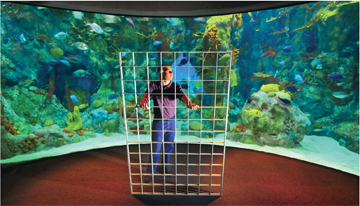
Where the surf hits the sand — beaches — are places of unique physical beauty and natural recreation. Beaches figure prominently in most memories of childhood and are firmly cemented in popular culture. Think of the Beach Boys, Beach Blanket Bingo, or the thousands of cities with “beach” in their name.
Shifting tides mean that beaches are never quite the same from one hour to the next. This quality presents a challenge for physical security at what is referred to as the “land-water interface” or LWI.
“This hasn’t been done before,” says Michael Ross (6481). “Sandia has expertise in land barriers and there are mature surface barriers and active acoustic technologies for deeper water, but what’s missing is the interface between the two — especially in the littoral zone [the zone where sea and shore meet].”
Michael is the principal investigator for a project to develop a solution to this problem. The idea is create something called a “defeat barrier” that will extend from the shore out as far into the sea as necessary.
The project is a collaboration with the Applied Physics Laboratory (APL) at Johns Hopkins University. Sandia provides the expertise in physical security on land, while APL has the underwater expertise.
The defeat barrier combines simple physical security — a grate-like fence — with detection technology to sense a breach. Along with the barrier, other technologies are used to detect movement under water or climbing over or under the fence, and a variety of cameras provide alarm assessment and situational awareness. The defeat barrier itself will extend from below the sea floor to above the high tide level, and the length will depend on the physical characteristics of the site.
While the concept is relatively simple, deploying it in a marine environment throws layers of complication at the problem. The complex littoral environment, says Michael, drove the design decisions.
Any barrier for physical protection must fit into environmental constraints. The obvious solution would be a solid causeway extended into the water to the point where deeper water technologies can take over.
“The littoral area is environmentally sensitive,” says Michael. “You have to allow water and small wildlife to pass through any security system. It’s a challenge to create a design that meets the security requirements and is environmentally friendly.”
The marine environment also presents a number of unknowns, as many of the components have never been used in salt water. The defeat barrier and other physical protection system components are being deployed at a test bed in Florida for performance measurements and to see how they handle salt water and extreme weather over the long term. Don Sheaffer (8136), an electrical engineer working on the project, says that biofouling could be an issue, if the sensors and other equipment need frequent cleaning.
“This defeat barrier must have a zero false alarm, zero nuisance alarm rate. Any failure is catastrophic,” he adds. “And how do you install the defeat barrier so it is sturdy enough to withstand whatever Mother Nature might throw at it? We’re going to find out.”
In March, Sandia initiated video assessment testing. Using an existing pier off the Florida beach, video cameras are detecting movement in 180 different scenarios.
What happens in extreme fog? At sunrise and sunset? When the noonday sun reflects off the water? What if an intruder is dressed in black or silver? Ten-second clips showing breaches in these conditions and others will be shown to a team of 30 potential operators of the system.
The mechanics of the defeat barrier are automated — any breach would set off a sensor alarm — but the final assessment is always made by an operator monitoring video images captured from the area where the alarm was produced. The defeat barrier’s effectiveness is only as good as those images.